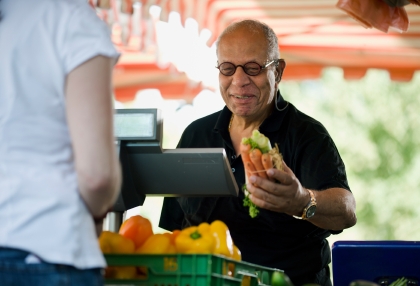On July 16, 2003 in Santa Monica, California, a private passenger vehicle drove through a farmers market contacting vendor displays and pedestrians before stopping. The accident resulted in the deaths of 10 people, and 63 others obtained minor to severe injuries. The driver occupant was uninjured.
According to the National Transportation Safety Board (NTSB), the probable accident cause was failure of the driver to maintain control of the vehicle resulting from unintended acceleration. The National Transportation Safety Board's Highway Accident Report also said the lack of a barrier system to help protect pedestrians in the Santa Monica's Farmers Market from errant vehicles contributed to the accident severity.
The above incident is clearly an unfortunate tragedy resulting in bodily injuries and loss of life, significant property damage, and subsequent lawsuits.
This article will provide a risk management strategy for managers of farmers markets to assist in hazard recognition, thereby increasing property protection and public safety.
History Of Farmers Markets
The U.S. Department of Agriculture (USDA) has estimated the number of farmers markets has increased 79% exceeding 3,100 nationally from 1994 to 2002. In 2004, the number topped 3,700. The U.S. Department of Agriculture has no Federal enforcement or regulatory authority over farmers markets. It maintains a national database of market locations (inclusion is voluntary), and the database does not specifically record safety issues affecting farmers markets. Discretion of local authorities decides on market place location, permitting requirements, and applicable traffic control plans to ensure the market safety.
Regulatory Requirements
In California, the State's Department of Agriculture certifies farmers markets. The state has over 300 Certified Farmers Markets (CFM's) with 80 domiciled in Los Angeles County limits. Only certified farmers, governmental entities, or nonprofit organizations can operate a Certified Farmers Market within the state. Each individual vendor and market's operator must receive certification from their respective county's agriculture commissioner. Regulatory agencies' requirements vary in each state, county, and city regarding food and agriculture health and safety codes.
Farmers Markets Are A Valuable Part Of The Community
Farmers markets provide communities with nutritious, fresh, affordable, and local farm products, allowing farmers to increase profitability by directly selling to consumers. In 2000, 19,000 farmers sold their produce exclusively at farmers markets resulting in a larger share of direct profit to farmers.
Consumers also enjoy the opportunity to buy fresh, high-quality products direct from farmers at competitive prices. Farmers markets also foster food and community linkages by helping children to learn where their food comes from, bringing neighbors together, and permitting families to talk directly with farmers and growers who produce their food.
Farmers Market Safety
Farmers market managers play a key role in the overall safety of vendors, customers, and adjacent businesses. The time to plan for safety and security is prior to the market opening. Pre-arrangement with local fire, police, and emergency personnel regarding premises access and physical barriers, parking and traffic flow, crowd control, first aid, etc. need to be coordinated and contingency plans developed, reviewed, and practiced.
Next, a hazard assessment of specific risks needs to be performed. For a comprehensive list, refer to our Farmers Market Safety Checklist. Some of these farmers market areas to evaluate include:
Entry/Exit Ways
- Adequate barriers, orange warning cones, etc. provided to/from market areas.
- Pets not allowed in market areas.
- Use of bicycles, skateboards, roller skates, roller blades, and in-line skates, etc. prohibited and properly signed in market areas.
Sidewalks
- Walking/working areas provided with even surfaces and no potholes.
- Changes in elevation and abrupt surface edges provided with warning markings, signage, etc.
Parking Lots
- Parking stalls provided free of potholes and other obstructions.
- Curb bumps/parking blocks properly secured and highlighted.
- Vendor vehicles such as large trucks, vans, etc. provided with wheel chocks or blocks to help prevent movement.
Vendors' Equipment/Set-Up
- Market manager and/or assistant manager trained in emergency procedures, including first aid, emergency response, earthquake preparedness, bomb threat, etc. and coordinated with local authorities.
- Fully approved first aid kit and fire extinguisher provided at main location.
- Vendors required to have "standardized" display tables, supports, awnings, and umbrellas approved by the market manager.
Market Areas
- Vegetation, including tree branches, shrubs, etc. kept from obstructing sidewalks, parking lots, common areas.
- Lawn sprinklers installed away from common areas to prevent trip and fall hazards.
- Leaves, debris, etc. removed from walking surfaces to reduce "trip and fall" hazards.
Special Hazards
- Areas under construction, repair, or modification properly barricaded/fenced with appropriate warning lights and/or flashing beacons.
- Customers and employees restricted from fenced/barricaded construction areas.
- Night operations require adequate illumination along market areas, sidewalks, and parking lots. Lights and fixtures need to be continually inspected and maintained for proper operability. Additional security and police may be needed.
Additional Concerns/Comments
- Review special event planning with local officials to make sure premises access, crowd control, and traffic flow exposures have been evaluated.
- Coordinate security procedures and plans with local authorities such as theft prevention, crowd control, disorderly persons, preservation of cash boxes, etc.
- Provide adequate market management staff and maintain current list of volunteers and substitutes.
- Market staff trained in incident and accident investigations including documentation for report forms and contacting insurance adjusters and local authorities.
Protecting farmers markets from financial loss due to property damage, bodily injuries, vehicle damage, and employee accidents is essential. "Liability insurance is one of the major expenses for certified farmers markets. This cash demand can be a determining factor in whether or not a market gets off the ground. It is important that market organizers know something about obtaining the best deal for their insurance dollar." — From Organizing a Certified Farmers Market by the California Department of Food and Agriculture.
In addition to commercial general liability insurance, farmers markets need to secure insurance coverage for property, auto, directors' and officers', and workers compensation.
Special events or services such as "bounce houses" and pony rides may require contractual agreements and insurance certificates from vendors as well as specific event coverage.
Products liability concerns from consumption of contaminated food products or produce that are prepared or stored incorrectly need to be addressed. In addition, local health officials need to be consulted regarding rules about offering food or product samples, selling prepared, processed, and ready-to-eat foods, restroom facilities, etc.
The future growth of farmers markets throughout California and the nation is undeniable.
Operating markets provide communities with locally grown, farm fresh produce and the opportunity to interact personally with farmers and growers. Farmers markets also assist with promoting education on nutrition, healthy eating habits, improved food preparation, and increasing each community's economy.
For farmers markets to be profitable, a specific risk management strategy needs to be developed, implemented, and monitored. To help prevent and minimize losses to customers, employees, vendors, and damage to property and vehicles, a hazard assessment of specific risks needs to be conducted. Finally, farmers markets need to evaluate all activities for appropriate insurance coverages and contractual agreements.
Eat fresh and enjoy your next visit at your local farmers market.
References
Agriculture Marketing Service (AMS), U.S. Department of Agriculture, "Farmers Market Growth", February 2005, http://www.ams.usda.gov/farmersmarkets/farmersmarketgrowth.htm
FoxNews.com, "Car Plows Into Crowded Santa Monica Farmers Market", July 17, 2003: 1-3.
National Transportation Safety Board, "Rear-End Collision and Subsequent Vehicle Intrusion Into Pedestrian Space at Certified Farmers' Market, Santa Monica, California", August 3, 2004. http://www.ntsb.gov/publictn/2004/har0404.htm
University of California Davis, Small Farm Center, "A Guide To Managing Risks and Liability at California Certified Farmers Markets", 2003.





